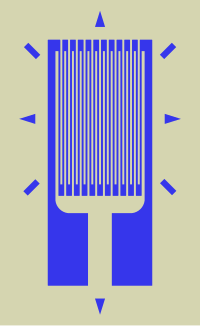
Photo from wikipedia
The application of strain to photovoltaics (PVs), thermoelectrics (TEs), and semiconductors often has substantial impacts on the fundamental properties governing the efficiency of these materials. In this work, we investigate… Click to show full abstract
The application of strain to photovoltaics (PVs), thermoelectrics (TEs), and semiconductors often has substantial impacts on the fundamental properties governing the efficiency of these materials. In this work, we investigate two stable phases of hybrid organic-inorganic two-dimensional (2D) perovskites (2DPKs) and their response to the application of tensile and compressive strain of up to 5%. These 2D MAPbI3 analogues are known to exhibit strongly anisotropic properties and have been put forward as excellent candidates for application in mixed PV-TE devices. Our results, stemming from ab initio density functional theory calculations and investigation of transport properties through the Boltzmann transport equations, further elucidate the key properties contributing to the success of these materials. In particular, both the M1 and M2 phases exhibit stable structures between -5 and 5% biaxial strains. The M2 phase exhibits an excellent 23.8% power conversion efficiency under the application of 5% tensile strain. Furthermore, we analyze the effects of spin-orbit coupling on the band structures of both phases, revealing great potential for spintronic applications with the M2 phase, demonstrating Rashba coefficients up to 3.67 eV Å.
Journal Title: ACS applied materials & interfaces
Year Published: 2022
Link to full text (if available)
Share on Social Media: Sign Up to like & get
recommendations!